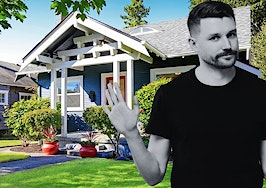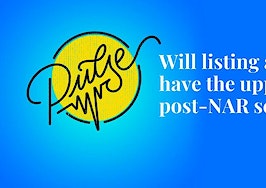This article series is largely taken from the Real Estate Marketing Playbook with permission from the author.
Direct mail is a fundamental part of your real estate marketing playbook. It is a versatile and personal method of getting the word out about your services, and why you are the best and most obvious choice.
However, because direct mail is such a vital tool, it’s easy to get overwhelmed when figuring out how to get started, and how to use it to get the results you want.
First thing’s first, you have to figure out your geo-farm. A geo-farm is a defined geographic area of households to which you send regular mailings over the course of a year, with the specific goal of increasing your number of listings.
You will need to determine an area that has a high likelihood of homeownership turnover, and then create awareness and familiarity among members of that community.
Through that effort, you should become the real estate agent of choice within that area. While this is a method that takes time and commitment, it can be advantageous and have long-lasting results. Here are a few things to consider.
Identifying the farm
The first thing you’ll need to do is determine your area to farm. Ideally, it is close enough to your home or office that you’re able to monitor the goings-on there and respond quickly to provide optimal service.
Many agents will farm the neighborhood they live in; however, it’s worth bearing in mind that some sellers will not want a neighbor knowing their personal information.
Avoid the temptation to select an area based solely on a high price point, or because you’ve lived in that neighborhood and have some history there. Choosing a location for reasons like these are driven either by the misconception that more money per transaction should be your primary goal or by an emotional attachment to an area. Neither motivation necessarily translates into a good foundation for your geo-farm area.
You’ll want to make a more thorough assessment of some critical factors to determine if a given area will likely net you a good return on your investment of time and money.
Turnover rates
It’s much more useful to look at the turnover rate of an area rather than home values, and to assess the number of transactions you’re likely to gain as a function of that rate.
The turnover rate can be calculated as the number of homes sold in a neighborhood over one year, divided by the total number of homes in that neighborhood. (Turnover rate = No. of homes sold / total No. of homes)
You can find this information by looking it up in the MLS or in tax records. Alternately, a software program called Realist allows you to search tax records for this information easily.
When you’re looking at the number of homes sold in your potential farm, it’s essential to use a polygon search (where you draw your own shape onto a map in the MLS system) instead of a wild card or neighborhood field. This will get more accurate results.
Because “neighborhood” is not a drop-down menu category in all MLS systems, it’s not always uniformly documented. Some people will spell the neighborhood name wrong, abbreviate it or not include it at all. When you search by polygon, the search covers everything within the boundaries of your shape, regardless of how it’s categorized in the system.
Choosing where to farm based on turnover rate will give you better results. Where homes sell more often, you have a higher likelihood of getting a listing. Even though an area has high prices, if there is little turnover, you’ll end up with fewer sales.
When choosing an area, ideally, you’ll want to see a 6 percent turnover rate or higher. Looking at the previous year’s data will be a good indicator of how many homes are likely to turn over in an area for the coming year. Sales trends can be monitored on a line graph, so as you start to see the turnover trend slowing, you might want to try farming a new area.
Average sale price
All of the above is not to say that home prices are irrelevant. You need to know the median sale price for homes in an area to assess your projected ROI. Search the MLS for areas where the average sale price is a sufficient amount to match your goal, and there is a decent rate of turnover.
Average days on market
Another consideration that needs to go into your assessment of a potential farm area is the average number of days homes stayed on the market. A neighborhood where homes sit on the market for a long time might not be as good of a target as an area where homes move quickly.
Often the best areas for geo-farming are those where home styles are more homogeneous, because they tend to sell more quickly. In older neighborhoods where every home has unique attributes, it can take longer to find a matching buyer for your listing.
Conversely, people looking in an area with mostly similar homes usually know the criteria they want and don’t require one specific house, because many homes in the area meet their needs.
Also, newer neighborhoods turn over faster, because initially, everyone is on the same buying cycle. Consider that people statistically move every seven to 10 years. In new communities where everyone bought around the same time when the development was brand new, they will likewise be hitting the seven-year mark at about the same time.
As neighborhoods get older, subsequent sales become more staggered, and turnover rates decrease because homeowners are no longer on similar buying cycles.
Another demonstrated trend is that townhouses tend to have higher turnover rates, as they typically attract more significant numbers of move-up buyers. People may have a shorter living cycle in a townhome before re-entering the market, and therefore a larger volume of sales occur in areas with a concentration of these types of homes.
Size of area
How big should your farmed area be? You don’t want to take on too big of an area since it costs time and money to market to your farm regularly. But, you also don’t want to select an area that is too small to give you sufficient listings to make it worth your while.
A rule of thumb is to target at least 500 homes. Your farm could even be a single building containing a large number of condominium units. There is no cap on how big your farm can grow, as long as your budget and time allow you to service the area with sufficient frequency and attention.
The frequency of contact is more important than the size of your target area. Asking 10 people for their business 10 times yields better results than asking 100 people just once each. If a homeowner isn’t thinking of selling right now, they may just toss your marketing away, and that would be a waste of your effort.
However, if you’re mailing to them multiple times, two things happen. First, the consumer will begin recognizing your name, and you’ll organically develop a brand as an agent who knows that neighborhood. Second, your chances of success increase proportionately to the number of times you send out marketing. The homeowner may not be selling today, but they might be three months from now.
Competition
It’s also worthwhile to see who else is already mailing in the area you are considering. If there is someone already dominating that market, it might not be the right place for you to focus.
For example, of the neighborhoods I researched, I determined that I could receive a 26 percent ROI in the Bonaire neighborhood. That would be great, except that I happened to know that someone from my same company was already mailing to this area.
I decided that in this case, particularly in light of the small number of homes in the area and low turnover rate, the competition was just too high and not a good investment of my time and money.
Frequency vs. reach
It’s important to be in touch with targets in your geo-farm on a monthly basis to become a natural resource to them. The rate at which you broadcast your message is more important than the number of people who receive it each time.
Some agents will contact their targets up to 24 times per year or every two weeks. However, we believe this level of frequency is risky. Not only are you doubling your mailing budget, but you may be in danger of alienating your target audience by annoying them. We recommend 12 mailings per year, one every month.
After 12 months (and 12 mailings), I look back to see if my targeting was successful or not. I look at turnover rates, at whether sellers who did list their homes called me, what percentage of area listings I got and which homes sold. I diligently gather as much information as possible to assess how I did, giving me insights from which to make business decisions for the upcoming year.
Overall, mailing areas and mailing lists will remain mostly unchanged from one year to the next, aside from dropping people who are no longer in the neighborhood. It’s crucial that you commit to the area you’ve chosen to farm and not make any drastic changes for at least a year.
What to send
Now that you’ve established a geo-farm to which you’ll mail at least once a month, you need to decide what to post. There are all sorts of companies out there trying to sell you marketing materials, including things like recipes, sports schedules, and seasonal or holiday items.
Don’t assume that recipients will hold on to your marketing, especially your first mailing. It may fail to get someone’s attention, particularly when they’re not planning a move anytime soon. People are busy, and they don’t look at what they consider junk mail.
Give the consumer something of value, such as market statistics for the area or recently sold comparisons. The most useful information you can provide to homeowners is real estate-related, generally in one of three categories:
- Evidence of success: a “just sold” card, noting percent of the listing price received and days on the market.
- A call to action: an announcement of buyers looking for homes, with specifics, mailed only to potential sellers meeting the sought criteria.
- An invitation to your landing page: a postcard that offers to help figure out the value of their home.
You might also send other things as a gentle reminder that you are available, with a piece of advice related to homeownership or information on a market trend. Remember that most people are very visual, so keep your marketing consistent to strengthen your brand. Avoid sending something with little to no value, such as a card with your branding but no content.
It’s best to alternate your messages each month, rotating consistently through each of the above categories. Vendors can help you coordinate your messaging. The additional cost of using a vendor is offset by the decreased cost per unit based on the volume of postcards being mailed.
“Just listed” and “just sold” postcards are potent marketing tools. Real estate often has a popcorn effect, in which multiple homes in one neighborhood go on the market at the same time soon after one home is listed.
A rush of new listings such as this is a great time to demonstrate your expertise in the area and gives the neighbors a taste of your professional marketing. Once the home sells, let the neighbors know with a “just sold” card, and be sure to ask for their business.
All of your marketing should suggest that you’re an expert in the area and at that particular price point. It should provide examples of instances where you successfully marketed a home and attracted qualified buyers.
Did you overcome any challenges during the transaction? Were there multiple offers? Did you receive an offer close to or above the original list price? Were you able to sell it in fewer days than the average for your market? Did you do something unique to market the property? These are all things that make for great attention-getters for your “just sold” cards.
There should also be a clear call to action, along with your contact information. You’d be surprised by how many agents overlook that detail.
At the end of the year, I sort our sales by style, location and price point to create postcards that feature anywhere from six to eight similar properties. Each card has a photo, a caption describing the property, the percent list-to-sale price and its days on the market.
We do not use actual listing or sales price because it’s irrelevant. The consumer may have a preconceived idea of the value of their home. What is essential is to illustrate how close we were to the actual sales price and how quickly the seller was able to move on.
You should also be sending these same messages out via your website and social media. Photos, stories and testimonials from clients are very effective ways to advertise.
Real Estate Marketing Playbook was inspired by observations and experiences over many years in the real estate business. This series includes example strategies from the playbook, and the full text is available on Amazon, Kindle and Audible.
Brandon Doyle is a Realtor at Doyle Real Estate Team — Re/Max Results in Minneapolis and co-author of Mindset, Methods & Metrics – Winning as a Modern Real Estate Agent. You can follow him on Twitter.













